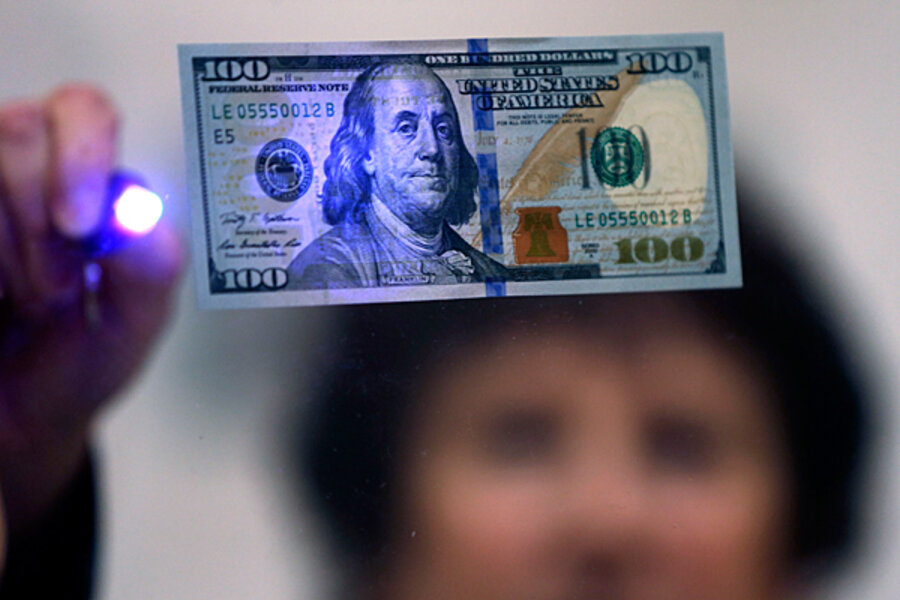New $100 bill: why North Korea won't be very happy
Loading...
Ben Franklin is about to cause a lot more headaches than you might expect in the North Korean capital of Pyongyang.
The Federal Reserve on Tuesday began circulating a redesign of a US currency note that may be the most counterfeited monetary unit in the world: the $100 bill.
Graced with Mr. Franklin’s bemused gaze on one side and Philadelphia’s Independence Hall on the other, the bill is the first new version of the C-note to be distributed by US monetary administrators in a decade. The note features a woven “3-D security ribbon” running vertically along the left side of Franklin’s face, with liberty bells that turn into 100s as you move the bill side to side. It also has a liberty bell in an inkwell that shifts in color as you tilt it.
These changes add to other longstanding security features, like microscopic text woven into Franklin’s colonial collar and bordering the golden feather.
"The new design incorporates security features that make it easier to authenticate, but harder to replicate," Federal Reserve Board Gov. Jerome H. Powell said in a statement. "As the new note transitions into daily transactions, the user-friendly security features will allow the public to more easily verify its authenticity."
The Fed, along with the Treasury Department, the Secret Service, and other agencies, has been redesigning all American currency bills since 2003, in an effort to stay ahead of counterfeiters, whose work has gotten easier as desktop publishing software has gotten more powerful and laser printers and photocopiers more capable.
While currency counterfeiting may be known in the popular imagination as the work of backroom, ink-stained criminals, impoverished North Korea has long been known for its creative efforts to generate badly-needed hard currency. The totalitarian state has been all but quarantined from the global economy, isolated by sanctions and other measures to punish it for its nuclear programs and missile proliferation efforts.
A combination of famine and floods in the 1990s that may have killed as much as 10 percent of the population, combined with the sharp post-cold war decrease in aid from Moscow and Beijing, brought the Kim regime to the point of desperation, and prompted some tinkering with the Korean currency, the won, that only worsened matters for average Koreans.
Even before the devastating famine, counterfeiting a variety of goods was central to revenue generation, helping to build a “palace economy” to ensure the loyalty of North Korea’s elites, says Sung-Yoon Lee, a Korean expert and assistant professor at The Fletcher School at Tufts University.
“North Korea is unique in that it is the only country in the world to manufacture cigarettes, drugs like Viagra, hard currency; this is an essential instrument of regime preservation,” Mr. Lee says.
“The regime relies on criminal activities, because it has no other means for generating revenue,” he says.
North Korean forging prowess is so advanced that US law enforcement officials have dubbed the fake, “nearly perfect” $100 bills “supernotes.” According to a 2009 Congressional Research Service report, at least $45 million in supernotes of North Korean origin have been detected in circulation, and Pyongyang may earn between $15 million and $25 million a year from counterfeiting.
North Korean diplomats often play roles in getting fake bills into circulation, lugging suitcases packed with bad money to their home embassies, then spending the bills in small, innocuous amounts in stores, casinos, restaurants, or elsewhere.
According to the Korean newspaper The Chosun Ilbo, one North Korean embassy in Eastern Europe generated US$30 million by exchanging counterfeit notes a year.
Lee added that it was only a matter of time before the North Koreans mastered the new design. In the meantime, sham Marlboros and other cigarette brands were likely to remain a more lucrative means for revenue-generation:
“You just put wrap up some tobacco in paper, put them in boxes, and ship them out. No one can tell,” he says. “The revenue is pretty sweet. With fake $100 bills you have to be careful, especially when government officials are using them abroad, since they’re being watched all the time.”







